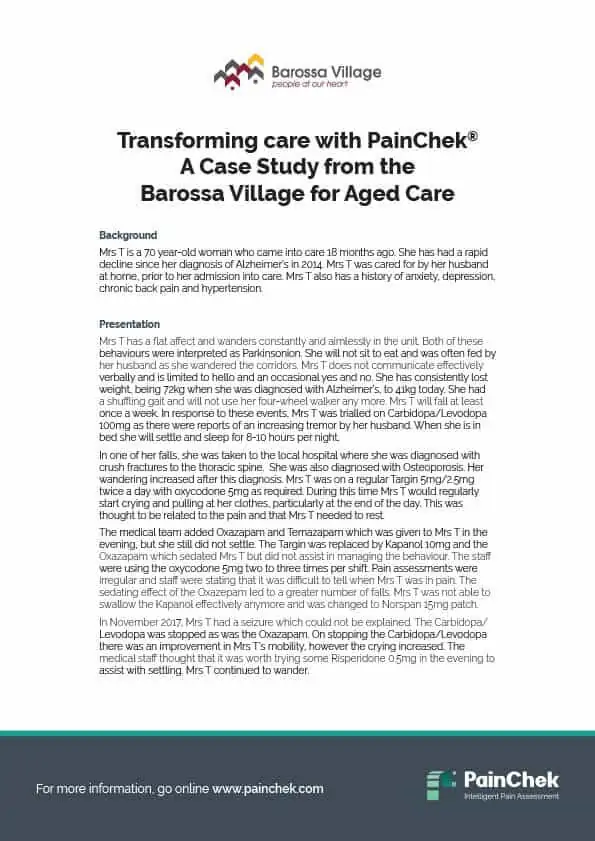Residential Care Partner: Barossa Village Aged Care Home
General Manager: Matt Kowald
PainChek first used: November 2017
Approximate No. of assessments: >700
Key PainChek® benefits.
Reduced resident pain levels through better assessment and more accurate treatment.
PainChek® assessments also helped to overcome some of the resident’s articulation of her pain, as English is not her first language.
Improved resident’s agitation and aggression towards staff.
72% increase in the number of pain assessments for cognitively impaired residents.
Background.
Mrs X is 79-year-old woman who has been living in the memory support unit for two years. She is originally from Northern Europe and English is not her first language. She had been diagnosed with Alzheimer’s and mixed dementia nearly 10 years ago.
Mrs X had a fractured tibia in 2009 after she had a fall off a ladder. She was diagnosed with breast cancer in 2013, which was managed with a mastectomy, chemotherapy and radiotherapy.
The catalyst for Mrs X coming into care was that her husband was unable to manage her personal care needs and her explosive outbursts. Mrs X would frequently hit Mr X and try to leave their isolated property in the evening.
Presentation.
Over the past two years, Mrs X has gradually deteriorated, and she is having more difficulties finding words and articulate her needs. Recently, Mrs X has been hitting and kicking out at staff. Mrs X has been on regular Panadol Osteo for many years. Mrs X has also started to spit out her medication and is speaking more in her native tongue. No abnormalities were detected in her blood tests, in her urine and when listening to her chest.
Outcomes.
On observing Mrs X, she was getting more agitated, aggressive and tired and during this time we organised an assessment by Dementia Support Australia. They recommended staff to look closer at pain, review her medication and review the behavioural interventions that are in place for her. All recommendations were followed by staff.
PainChek® was employed to assess Mrs X’s ongoing pain level on a regular basis. As a result, Mrs X was initiated on a Norspan 5mcg patch (as she was also continuing to spit out her oral analgesic medication). PainChek® was again used during the introduction of the patch to monitor Mrs X’s pain.
Mrs X’s pain scores constantly went down from a ‘mild pain’ (PainChek® score =7) in January to ‘no pain’ (PainChek® score =2) in April. The PainChek® scores were correlated to behaviour charting and this information was used to formulate an ongoing treatment plan, which subsequently improved Mrs X’s behaviours.
Secondary findings.
Regular use of PainChek® by staff provided better communication with the GP when he reviewed Mrs X’s treatment plan, particularly around eliminating pain as a causative factor for the behaviours being exhibited.
Further, there has been a significant increase in the number of pain assessments for residents with dementia and those with cognitive impairment. These assessments have been followed by therapeutic interventions for those who experience pain.
“Since we introduced PainChek® as a standard pain assessment tool for cognitively impaired residents in our facility, we have had a 72% increase in the number of pain assessments completed. This has translated into more pain interventions applied, including PRN medications and therapy-based solutions”.
Matt Kowald
General Manager
Residential Care Services




